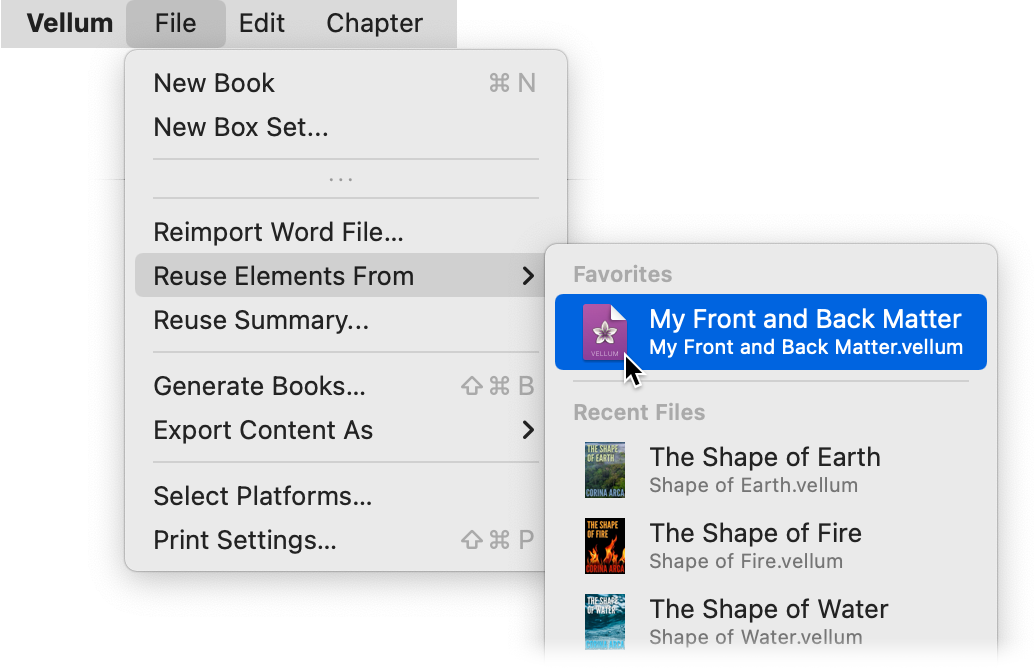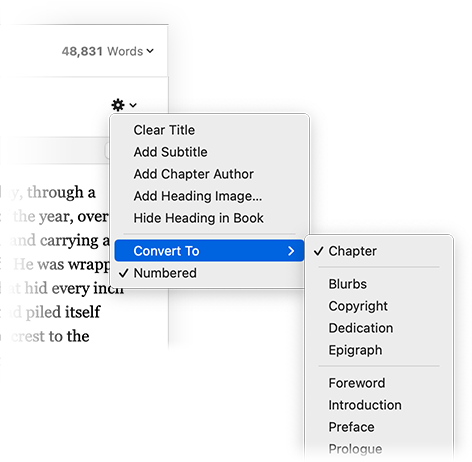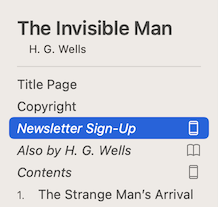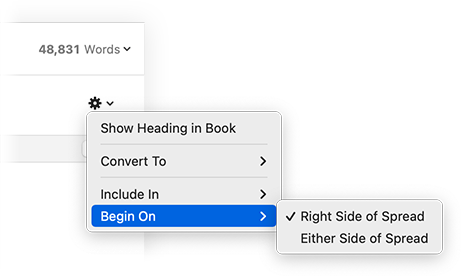Elements of Your Book
In Vellum, an element refers to an indvidual chapter of your book or a piece of additional material such as a Dedication or Acknowledgments.
Many of the elements of your book will be created when you import your manuscript. You can complete your book by adding elements like a Copyright page at the beginning of your book, or an About the Author page at the end.
- Adding Elements
- Deleting Elements
- Reusing Elements
- Element Types
- Edition-Specific Elements
- Side of Page Spread
- Element Type Catalog
Adding Elements to Your Book
To add a new element to your book, use Add Element, found in the gear menu at the bottom of the Navigator:

Select the element you’d like and Vellum will add it to your book. You can also find Add Element in the Chapter menu at the top of the screen.
Deleting Elements
To delete an element, such as an unwanted chapter, select it in the Navigator and use the Edit ▸ Delete menu item or press ⌘ Delete. You’ll also find a Remove command in the gear menu shown above.
Reusing Elements
Elements like About the Author and Also By are often repeated. To reuse these elements across multiple books, you can use File ▸ Reuse Elements From:

More details can be found in Reusing Elements.
Element Types
Every element in your book has a type, such as Chapter or Acknowledgments. An element’s type affects how the element is formatted as well as the overall structure of your book.
If you’ve titled an element explicitly, then Vellum will display its element type immediately below the title:

Note: Numbered chapters will not display the element type since the presence of a number to the left of the title uniquely identifies the element as a chapter.
Why Element Types Matter
- Drop Caps
- Book Style flourishes like Drop Caps are only used in Chapters. They won’t be used in front matter such as a Copyright page.
- Page Numbers
-
In your print edition, page numbers start with the first Chapter of your book (or Prologue if your book includes one). Page Numbers are excluded from most front and back matter.
Note: Some pages of Front Matter, such as an Introduction, will use Roman page numbers (i, ii, iii, etc.)
- Table of Contents
- Unlike most other elements, a Dedication or an Epigraph will not be listed in your book’s Table of Contents.
- Start Page
- In your ebook, the element’s type is used to determine your book’s Start Page, or what a reader first sees when she opens your book.
Converting Elements
If you need to change the type of an element, you can do so using the Convert To menu, found in the gear menu for an element:

You’ll also find Convert To in the Chapter menu. You can use this version of the command to convert multiple elements at once, if necessary.
Edition-Specific Elements
You may find that some elements only make sense in an ebook, such as a newsletter sign-up page.
You can use Include In, found in the title gear menu, to indicate that an element should only be included in Ebooks, or only in your Print Edition:

Note: This switch is only available for front and back matter. It is not available for Chapters in your book. You can, however, use it for chapters added as a teaser.
Edition-specific elements are italicized in the Navigator, with icons that indicate whether they are ebook-specific or print-specific:

Side of Page Spread
In your print edition, Vellum begins most elements of front and back matter on the right side of a page spread. To achieve this, Vellum may insert a blank page on the left. You can control this behavior using the Begin On menu:

Choose Either Side of Spread if you’d like the element to begin on the page immediately following the previous element. Your Copyright Page, for instance, defaults to this behavior.
Unlike other front and back matter elements, Full Page Images have an additional option that allows them to appear on the left side of a page spread.
Note: This option is only available for front and back matter included in your print edition. Use Print Settings to control the behavior of chapters in your book.
Element Type Catalog
- Blurbs
- A collection of brief quotes reviewing the book (or other works)
- Half Title
- A page that only includes the book’s title
- Title Page
- A page displaying the book’s title, author, and publisher
- Copyright
- Legal and publication information about the book, including ISBN
- Dedication
- A short inscription dedicating the book to a person or group
- Epigraph
- A relevant quotation that precedes the main content of the book
- Table of Contents
- Displays links or page numbers for chapters of the book
- Foreword
- Introductory section written by some one other than the author
- Introduction
- A section introducing the scope or nature of the content
- Preface
- An introductory section typically written by the author
- Prologue
- Sets the background to a story and is part of the narrative
- Epilogue
- Concluding section from a later point in time than the story
- Afterword
- Ending section that may detail history or significance of the work
- Bibliography
- A list of external references cited in the work
- Acknowledgments
- Lists and thanks entities involved in the realization of the book
- About the Author
- A brief bio, website links, and profiles on Facebook, Instagram, etc.
- Also By
- Other titles published by the author, and links to purchase them
- Uncategorized
- A generic piece of front or backmatter, when nothing else applies
- Full Page Image
- A page consisting of a single image, such as a map
- Part
- A section of the book, comprising multiple chapters
- Volume
- A group that represents a single book within a Box Set
 Vellum Help
Vellum Help